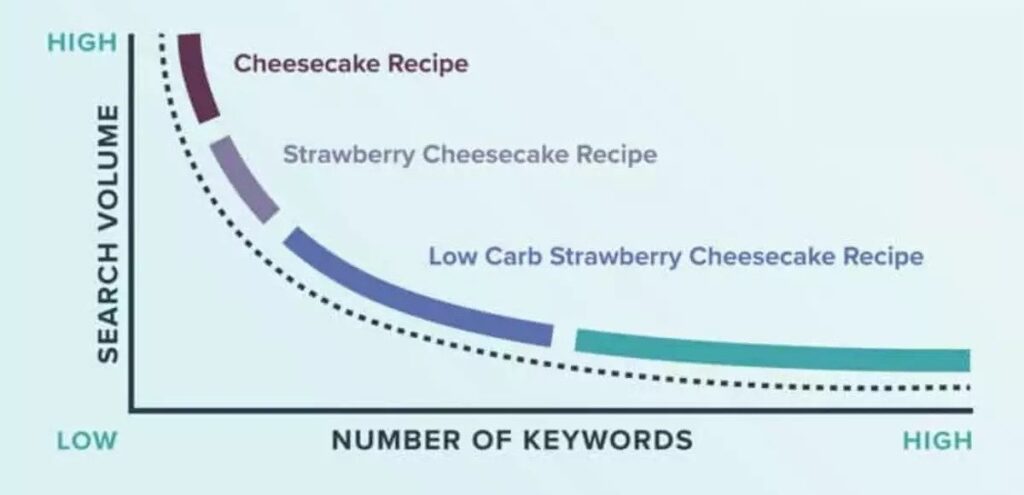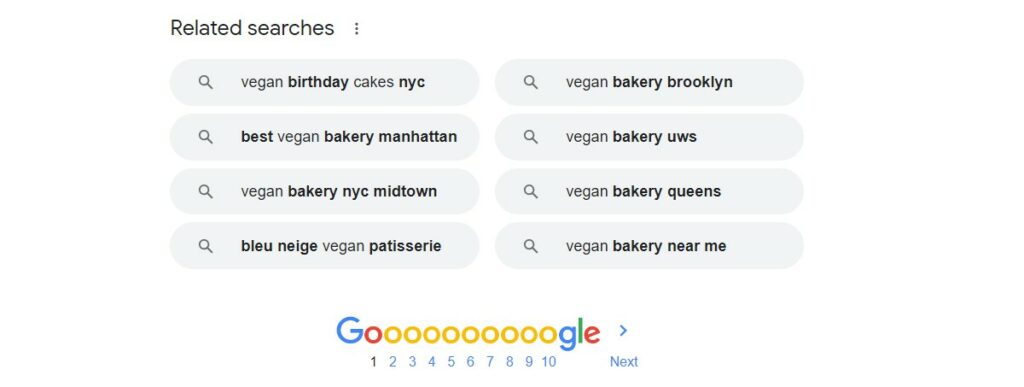*This article was last updated on 18/10/2023
If you’ve ever wondered how certain websites end up on the first page of your search results, the answer lies in effective keyword research. But among the myriad of keywords, one type stands out for its power to drive traffic and boost conversions – the long-tail keyword.
Understanding and effectively using long-tail keywords can be your guiding beacon in the vast ocean of SEO. They are specific, targeted strings of words that internet users will likely use under particular circumstances.
Understanding Keywords in SEO
a keyword is a word or phrase that describes the content on your page or post best. It’s the search term you want to rank for with a specific page. When users type this keyword or phrase into search engines like Google, ideally, your website should appear in the search results.
Keywords can be a single word, but more often than not, they tend to be phrases that internet users are likely to use when searching for specific content, products, services, or information online.
For example, if you’re running a vegan bakery in New York, “vegan bakery New York” could be a potential keyword for your business.
Types of Keywords
Body Keywords are 2-3 word phrases with a good search volume, less competition than head keywords, but still quite competitive. An example would be “vegan bakeries.”
Long-Tail Keywords are longer phrases very specific to whatever you are selling or writing about. They generally have less search volume but less competition and a higher conversion rate, making them particularly valuable for SEO.
In this article, we’re focusing on the third type, the long-tail keywords, which can be a game-changer for your SEO strategy when used correctly. They might not bring in the highest traffic volume, but the traffic they do attract is highly targeted, which can lead to higher conversion rates. Let’s explore this in more detail.
What are Long-Tail Keywords?
Long-tail keywords are keyword phrases that are typically three to five words long. The term “long-tail” comes from search demand’s long, tail-like distribution. While head keywords make up the majority of search volume, the cumulative volume of search queries in the “long tail” of the distribution graph is significantly larger.
Long-tail keywords are precise and often reflect the user’s intent more accurately. For instance, someone searching for “vegan chocolate birthday cake delivery in New York” has a particular need compared to someone searching for “cake.”
Examples of Long-Tail Keywords
To fully appreciate the concept of long-tail keywords, it’s essential to see real-life examples. A standard keyword might be something very general, such as “coffee.” While this keyword is highly searched, it’s also highly competitive and doesn’t provide much context about the searcher’s intent.
However, long-tail keywords add specificity to the search term. For instance, “best organic coffee beans online” or “fair trade Colombian coffee near me.” These long-tail keywords provide clear insight into what the searcher is looking for.
Another example could be the keyword “shoes.” Again, it’s a highly competitive term searched by millions of people. However, “men’s waterproof hiking shoes size 11” is a long-tail keyword that indicates the specific type of shoe and the size, making it a more targeted and valuable keyword.
Lastly, let’s take an example from the travel industry. The keyword “flights” is very generic and highly competitive. However, “cheap round trip flights from New York to London in July” is a long-tail keyword that gives much information about the searcher’s travel plans.
These examples illustrate how long-tail keywords work. They are longer, more descriptive, and provide clear signals about the searcher’s intent, making them valuable assets in your SEO strategy.
Why are Long-Tail Keywords Important?

There are several reasons why long-tail keywords are crucial for your SEO strategy.
There is Often Less Competition
Since long-tail keywords are precise, they typically compete less than generic ones. This means that it’s often easier to rank higher for long-tail keywords, especially for new or smaller websites that need more domain authority to compete for more competitive keywords.
They Usually Get Better Conversion Rates
Users searching with long-tail keywords are often further along in the buying cycle, meaning they’re more likely to convert.
In our earlier example, a user searching for “vegan chocolate birthday cake delivery New York” is likely ready to purchase, whereas a user searching for “cake” is probably just starting their search.
There’s a New Element of Voice Search Optimization
With the increasing use of voice search through digital assistants like Siri, Alexa, and Google Assistant, long-tail keywords are becoming even more critical.
People use more natural language and complete sentences when using voice search, so optimizing for long-tail keywords can help you capture this traffic.
They Open More Content Ideas
These special keywords can also inspire your content strategy. They can help you understand what information your audience is looking for, enabling you to create content that meets their needs and helps you rank higher in search engine results.
How to Find Long-Tail Keywords for Your Content

Finding the right long-tail keywords requires some research. Fortunately, plenty of tools can help you discover keywords related to your niche. Some of these include:
Google’s ‘Searches related to’ Feature
This is a free and easy way to find long-tail variations of your main keywords. Simply type your keyword into Google, scroll to the bottom of the results page, and find a list of related search terms that can inspire your long-tail keyword research.
By examining these suggestions, you can gain insights into the specific search terms people use about your topic. They can also help you better understand search intent, allowing you to tailor your content more effectively.
Google Keyword Planner
This free tool, designed initially for Google Ads, provides comprehensive insights into keyword search volumes, competition, and forecasts on future trends. But it truly shines when used for long-tail keyword research.
Google Keyword Planner returns many related keyword ideas when you enter a ‘seed’ keyword into the tool. Many of those ideas are long-tail keywords. It even allows you to filter and sort these results based on search volume or competition level parameters.
AnswerThePublic
What sets this tool apart is its focus on questions real people ask about a topic. When you input a seed keyword, AnswerThePublic generates many questions and phrases that users are searching for, often including long-tail keywords.
These come in the form of questions, prepositions, comparisons, alphabetical lists, and related searches. This can give you a comprehensive understanding of your target audience’s wants and the specific language they use to seek that information.
How to Use Long-Tail Keywords in Your Content
Once you’ve identified your long-tail keywords, the next step is to incorporate them into your content. Here are a few tips for doing this effectively:
Natural Integration: Long-tail keywords should be integrated naturally into your content. Forced or unnatural keyword usage can lead to a poor reader experience and potentially harm your SEO efforts.
Titles and Subheadings: Where relevant, use your long-tail keywords in subheadings. This helps with SEO and makes it easier for readers to skim your content. They’re also obvious to readers and search engines alike.
Incorporate into Meta Descriptions: Although meta descriptions don’t directly impact your rankings, they can influence click-through rates. A compelling meta description with your long-tail keyword can encourage users to click on your content.
Use in Image Alt Text: If you’re using images in your content, include long-tail keywords in the image alt text. This helps your images rank in Google’s image search and provides a better experience for users with visual impairments.
Anchor Text for Internal Links: Use your long-tail keywords as anchor text for internal links. This can help boost your SEO by showing search engines the relationship between your pages and reinforcing the topic of each page.
How to Monitor and Track Long-Tail Keyword Performance
Once you’ve implemented long-tail keywords into your content strategy, monitoring your progress and measuring the results is important. Here’s how you can do that:
Monitor Keyword Rankings
Track the performance of your long-tail keywords. Use tools like Google Search Console, SEMrush, or Ahrefs to see where your content ranks in search engine results for your targeted long-tail keywords. Remember, it’s not always about securing the top spot. Even lower rankings can drive significant traffic if the keyword is specific and relevant to a dedicated audience.
Analyze Organic Traffic
Assess the level of organic traffic driven to your site by long-tail keywords. An increase in organic traffic often suggests that your long-tail keyword strategy works. You can use Google Analytics to get insights into your site’s traffic.
Measure Engagement Metrics
Don’t just focus on traffic; look at engagement metrics too. Are visitors staying on your site, or do they leave quickly? Are they exploring other pages? High engagement rates can indicate that you’re targeting the right keywords and providing valuable content.
Conversion Rates
Perhaps the most critical metric is your conversion rate. Are your long-tail keywords leading to higher conversions? This might mean more newsletter sign-ups, increased sales, more downloads, or whatever action you want your users to take. Your long-tail keyword strategy is likely effective if you see a positive impact on your conversions.
Monitor Your Competitors
Keep an eye on what your competitors are doing. Which keywords are they targeting? How are they ranking? Tools like SEMrush and Ahrefs can provide competitive analysis to help you adjust your strategy if needed.
Implementing a long-tail keyword strategy is not a one-and-done task. It requires regular monitoring, adjusting, and optimization. But with the right approach, you can reach your target audience, improve your search engine rankings, and boost your conversions. Remember, the aim is to deliver valuable content to your audience that answers their questions and meets their needs, and these keywords are an effective way to do this.
Long-Tail Keywords: Your Key to SEO Success
Understanding and effectively utilizing long-tail keywords remains a cornerstone strategy in SEO. These specific and less competitive search terms can significantly impact your SEO performance by driving targeted traffic to your site.
Long-tail keywords allow you to align your content more closely with the intent of your audience, leading to higher engagement and conversion rates. They are a powerful tool in your arsenal that can help you create more focused, relevant content and, ultimately, achieve your SEO goals.
Keep learning, optimizing, and keeping your audience at your SEO strategy’s heart. Your efforts will pay off in the long run.

